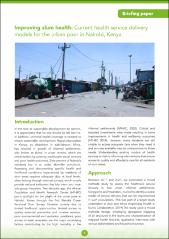| dc.description.abstract | In the race to sustainable development by nations,
it is appreciated that no one should be left behind.
In addition, universal health coverage is needed to
ensure sustainable development. Rapid urbanization
in Kenya, as elsewhere in sub-Saharan Africa,
has resulted in growth of informal settlements,
also known as slums, in urban centres, which are
characterized by poverty, inadequate social services
and poor health outcomes. Sixty percent of Nairobi’s
residents live in or under slum-like conditions.
Assessing and documenting specific health and
livelihood conditions experienced by residents of
slum areas requires adequate data at local levels,
often lacking through national surveys, which mostly
provide national indicators that blur inter- and intrasub-group inequities. Two decades ago, the African
Population and Health Research Center (APHRC)
put a spotlight on the plight of the urban poor in
Nairobi, Kenya through the first Nairobi CrossSectional Slum Survey. | |

